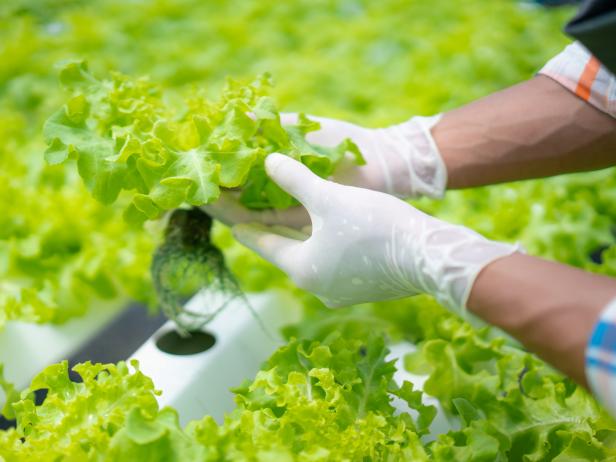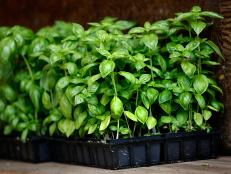What Is Controlled Environment Agriculture? And Does It Yield More Nutritious Produce?
You may have seen greens grown indoors — sometimes vertically, and without soil. How do they compare to their traditionally grown counterparts?

Sergey Mironov/Getty Images
Controlled Environment Agriculture (CEA) is a form of farming in which plants grow within a controlled environment to optimize horticultural practices. Instead of using large pieces of equipment such as tractors, as in traditional farming, CEA involves the use of other types of technology, like cameras and software to grow food.
So how does CEA fit in with traditional farming practices? And, compared to traditional farming, does it yield more – or less – nutritious herbs, fruits and vegetables?
What Are the Benefits of Controlled Environment Agriculture?
According to Matthew Lohr, Virginia Secretary of Agriculture and Forestry, the goal of CEA is to “provide protection from the outdoor elements and control all aspects of the growing environment.”
These methods of farming can allow for year-round production of locally sourced produce. In doing so, this helps reduce transportation-related emissions. Crops that couldn’t typically grow in a region’s outdoor environment, are able to do so within controlled indoor environments.
In addition, CEA requires less land and up to 95 percent less water compared to traditional outdoor farming. No pesticides are needed, and CEA leads to less food waste overall.
According to Lohr, the COVID-19 pandemic, and the supply chain disruptions that followed, highlighted the need for more locally sourced food. In Virginia, for instance, growing food indoors within the state adds an additional five days of product shelf life, while reducing transportation costs. Produce grown indoors can usually be on a grocery store shelf within 24 hours.

Kittikorn Nimitpara/Getty Images
What Are Some Types of Controlled Environment Agriculture?
CEA can take a variety of forms, and includes several methods such as hydroponics, indoor and vertical farming, greenhouses, artificial lighting and aquaponics. Here’s an overview of some of the more popular methods used.
Hydroponics
Hydroponics is a technique of growing plants, using water-based nutrient solution instead of soil. It can be used indoors and outdoors. Indoor hydroponics is typically used for lettuce, herbs and microgreens.
According to Alexander Olesen, CEO and co-founder of Babylon Micro-Farms, a company that sells automatic indoor micro-farms to restaurants, cruise ships, senior living homes and more, hydroponically grown greens offer the benefit of ultra freshness. People value the “convenience and reliability of growing them right on-site.”
There are many ways you can set up a hydroponic system. Here’s a detailed guide, if you’d like to try it at home.
With more technologically advanced set ups like Babylon’s, users can rely on the system to automatically provide plants with just the right amount of macro and micronutrients. “This may sound complicated, but our Micro-Farms automatically dose nutrients at the right time and in the right quantity, making it easy for anyone to do,” Olesen says.
With indoor systems, you can, of course, have greater control over growing conditions, making produce less likely to be affected by weather, pests and pollutants.
Indoor Vertical Farm
Indoor vertical farming is a practice of growing produce, like lettuce, stacked one above another in a closed, controlled and space-efficient environment. The method can include techniques like hydroponics, aquaponics or aeroponics – which involves growing plants without soil, and instead misting plant roots with water and nutrients.
Marc Oshima, co-founder and CMO of AeroFarms, a pioneer of vertical farming, explains that aeroponics allows the company to use “up to 95 percent less water for leafy greens than field farming and even less than hydroponics, as well as a fraction of the fertilizers and zero pesticides.”
In a hydroponic vertical farm system, such as the one at Farm.One in Brooklyn, New York, a water-based nutrient solution is delivered to multi-level racks of growing plants and their roots. According to Rob Laing, founder and chief revenue officer of Farm.One, the system is set on a “flood and drain” cycle, which recirculates the water continually throughout the day, so very little water is lost. The plants sit in blocks of a spongy grow medium, which gives their roots the support they need and access to the water.
LED lighting is also critical to indoor farming – in more advanced systems such as AeroFarms’, a specific lighting regimen for each type of plant is applied, giving them exactly the spectrum, intensity and frequency for optimal photosynthesis in the most energy-efficient way possible. “All of these factors get incorporated into a growing algorithm for each variety that we grow – allowing us to optimize the size, shape, texture, color, nutrition, and most importantly flavor for each of our plants with razor-sharp precision and increased productivity,” Oshima explains.
LED lighting also allows plants to get light for more hours a day, than they might in outdoor environments.
Because there is more precision in indoor growing, Laing explains that the crops appear to be identical and consistent throughout the year. Additionally, because indoor farms have less of a need for pesticides, plants can be selected for flavor and nutrition instead of hardiness or pesticide resistance. This type of farming also allows growers to grow near major population centers, reducing the distance between the customer and their food.
Is Controlled Environment Agriculture-Grown Produce Less Nutritious?
A handful of studies have looked at the nutritional difference between CEA-grown produce compared to produce grown using traditional farming methods. These studies found that some of the growing methods used in CEA may have actually have positive impacts on the nutrient quality of certain crops. However, according to a USDA interview on vertical farming, the nutrition and quality of produce grown by vertical farming are typically the same or similar to those produced under traditional outdoor farms.
How Does Controlled Environment Agriculture Fit Into the Farming System?
Laing explains that the produce most suited for indoor farming are the most perishable and fragile plants that require the most specific weather conditions, like herbs, leafy greens and some fruit (like berries). Indoor growing is much more costly compared to growing outdoors so large-scale crops like potatoes, wheat, soy and beets aren’t cost-efficient to grow indoors.
According to the 2020-2025 dietary guidelines for Americans, 90 percent of Americans don’t meet their recommended daily vegetable intake, while 85 percent don’t meet their recommended daily fruit intake. While indoor farming produced foods offer more options to consumers, they are relatively more expensive compared to traditionally grown produce, which may further deter people from purchasing them.
Indoor farming isn’t going to replace traditional outdoor farming methods. “It complements existing agricultural practices by addressing real challenges like land availability, urban food production and climate variability,” says Olesen. “Both systems can coexist and contribute to global food production in their respective ways, depending on the needs, resources and constraints of a region.”
In addition, AeroFarms has partnered with different public and private groups like the USDA and the Foundation for Food and Agriculture Research's Precision for Indoor Plants to share key learnings from its indoor vertical farms and ultimately help inform the broader agricultural community, creating a more resilient food system.
“Over the next 10-20 years, as climate change makes weather more extreme and unpredictable, and water scarcity increases, you will see more crop types grown indoors to take advantage of the predictability and location-independence of this type of growing. Hopefully, over the next decade or two the world of indoor farming will help with produce consumption to feed the growing number of people,” says Laing.
Related Content:
































